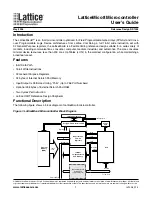
Hardware
CY4502 EZ-
PD™ CCG2 Development Kit Guide, Doc. No. 001-96601 Rev. *B
32
Figure 4-5. USB Type-C Plug Interface (front view)
Only one CC pin is connected through the cable to establish the signal orientation. The other CC pin is repurposed as
VCONN for powering the electronics in the USB Type-
C plug. Also, only one set of USB 2.0 D+/D− wires is implemented in
a USB Type-C cable. SBU signals are used in Alternate mode, supported by the Type-C specification. The USB Type-C
specification supports Alternate mode, which enables multipurposing Type-C signals for alternate uses such as the display
port. It allocates lanes to those other signals as necessary, with muxes at either end (host/device) handling the switching to
determine which signals are on which lanes and where they need to come from or go to. Refer to the
for more details on Alternate mode. In Alternate mode, activity on the SBU lines does not interfere with USB PD BMC
communications. SBU signals are not implemented for USB 3.0/USB2.0-only cable applications.
signals used on the USB Type-C connectors.
Table 4-1. USB Type-C Plug Signals
Signal Group
Signal
Description
USB 3.1
SSTXp1, SSTXn1
SSRXp1, SSRXn1
SSTXp2, SSTXn2
SSRXp2, SSRXn2
The SuperSpeed USB serial data interface defines one differential
transmit pair and one differential receive pair.
On a USB Type-C plug and receptacle, two sets of SuperSpeed
USB signal pins are defined to enable the plug flipping feature.
USB 2.0
Dp, Dn
The USB 2.0 serial data interface defines a differential pair. On a
USB Type-C receptacle, two sets of USB 2.0 signal pins are defined
to enable the plug flipping feature.
Configuration
CC
CC channel in the plug used for connection detect and interface
configuration
Auxiliary signals
SBU1, SBU2
Sideband use
Power
VBUS
USB cable bus power
VCONN
Type-C cable plug power
GND
USB cable return current path







































